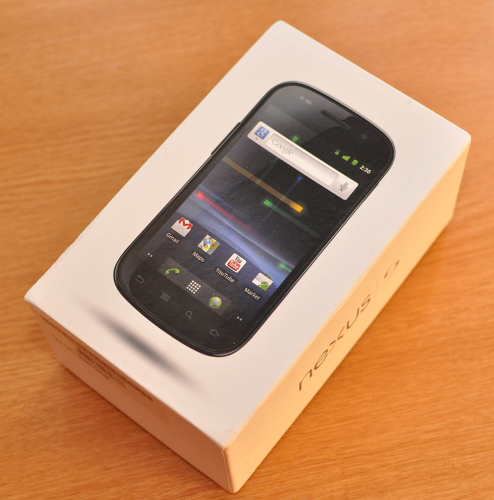It’s here! In a nice, crisp white box, stuffed in a cruddy DHL delivery bag and dropped off at the door by a man in a Peugeot 206! DHL… delivering via an ancient hatchback? Strange indeed. But still, that was all forgotten with the excitement of getting my grubby mit on a new piece of hardware.
Not only hardware of course, but software as well.
So, lets start this series off by taking a once over on the hardware. I don’t really have a frame of reference for hardware outside of the iPhone – so I will have to compare it to that and I suspect that most would agree that the iPhone is the best kit to compare it to for the purposes of this series.
Without being turned on, the Nexus S has an amazingly dark look. The inactive screen is almost completely black and is indistinguishable from the surround. This gives an almost seamless look to the gently curving front screen. The reverse of the phone has a slight pattern to it, almost mock carbon fibre. It also has a slight bump at the bottom of the phone making it easy to grip in the hand.
The case is unmistakably plastic. That shouldn’t really be read as “cheap feeling” as it is a solid device, however, like a heavy watch always reassures you there’s a good mechanism below the surface, you might expect to feel a little more weight behind this device.
One advantage of the plastic and the shape of the phone, is that it is very easy to keep hold of! I’ve had my iPhone slip out my hand on a couple of occasions due to it’s sleekness and I can’t see this happening with the Nexus S.
Things really start to sing with the device once you turn it on. It has a AMOLED screen that absolutely screams at you with it’s vibrancy, resolution and unbelievable contrast. I realise that many other devices have got AMOLED screens and as such, this is nothing new, but this is the first time I’ve seen one properly in the flesh for any length of time, and it’s got me sold. It’s not as high resolution as the iPhone retina display, but it’s not a long way off. The blackness of the phone and the darkness of the new look of Gingerbread mean that everything just pops out and the icons seem to float in nothingness!
The live desktop is a nice effect, with moving walpapers to keep things interesting. I’ll go onto giving an initial impression of the software in another article so I’ll try not to get too sidetracked at this stage.
Digging into the phones settings, you’ve got all the fancy equipment everyone has come to expect. GPS, Wi-Fi, Bluetooth, Compass etc. So, as with the iPhone, the device can know where it it, at what angle and where and how it’s moving. The Nexus S adds Near Field Communication (NFC) to the parade – a communication for reading tags embedded in other objects. Think of the Oyster cards and some new credit cards. Also, know that it won’t really be a big deal for a good while yet. Probably until the iPhone gets it’s own NFC chip!
Also in the setting are options to turn the Nexus S into a mobile hotspot or to tether it to your laptop. For all the per-lava that surrounds this feature on iPhone and on mobile devices generally, it’s so refreshing to have an unfettered offering with all the extras available. This will surely be the first feature to be turned off by carriers when the next Gingerbread devices are available.
The in build speaker in the Nexus S is disappointing. The iPhone speakers – or device speakers per-say – are not that strong in general, but this speaker is particularly weak. The sound output of the phone through the jack socket is also low. I have to crank my speakers in the kitchen right up to get some decent levels whilst doing the washing up. The in-ear buds are fairly comfy for my ears (much better than the white Apple buds.) The sound is better through the earphones as you would expect and the volume is less of an issue, but I’m used to devices being able to blast you to smithereens if you so wish, and you can sit with the volume at full with no issues.
The phone is the right size. There are lots of devices out there that are getting bigger… getting on for comical. The Nexus S is nicely pocket sized and positively mobile.
So, an encouraging start with the device. Sound aside, everything feels nice and solid. Wi-Fi has been good enough across the house and the phone hasn’t struggled with any of the trials I’ve subjected it too so far. In fact, it’s been pretty faultless and very snappy. Comparing it to my creaking iPhone 3G is night and day. I’m confident that iPhone 4 users would appreciate a comparable speed of operation.
In the next part of the series, I’ll be looking at setting up the phone infrastructure – how can you recover the ability to sync your music collection and podcasts? What accessories are available? How do you get to use your phone as you are used to?


